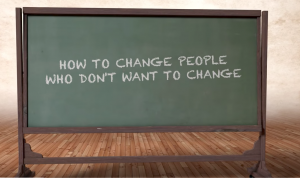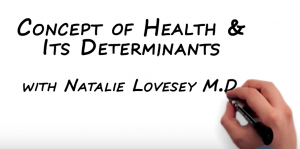38 Coursework: An Example of Integration
Madison Roberge
As my Health Advocacy program has been officially approved by Plymouth State University (YAY!!), it has become time for me to start learning and thinking like a Health Advocate. Wait, what does that even mean? My new-found love and future career is a combination of health promotion, health education, creation and implementation of wellness programs and advocating for improved or continued support for health causes. Two courses I am taking this semester that have complete enhanced my skill set as a future health advocator are Disease, Safety, and the Environment, and Health Promotion Planning and Evaluation. I cannot advocate enough the importance of these courses to anyone in the field health. The course description for Disease, Safety, and the Environment reads:
One of the largest focuses of the course is understanding how almost all aspects of health are connected. We examine the how external and internal factors influence our health and health behaviors to understand how to prevent disease from happening in the first place. Preventative health practices are a huge interest of mine which makes this course that much more interesting to me. To spread awareness of disease, safety matters, and environmental health we have been assigned a disease to educate ourselves on and create materials to educate the public. This assignment has taught me so much about health literacy. Health literacy is not a direct topic, but an indirect goal of the course as educating the public needs to be focused around making sure they can understand what we are presenting. According to Health.gov, Health Literacy is “the ability to obtain, process, and understand basic health information and services to make appropriate health decisions”. Health.gov survey results state that “77 million people would have difficulty with common health tasks, such as following directions on a prescription drug label or adhering to a childhood immunization schedule using a standard chart.” Table 1. Descriptions of Health Literacy from health.gov explains the literacy rates a little more.

The course has taught me that almost all health information delivered to the public needs to be written at a reading level of 6th to 8th graders. My professor for the course provided us with a Readability Formula to calculate the reading level of the information on our disease fact sheets. Writing health information at a 6th to 8th grade level is so much harder than I thought it would be.
 My flyer on Peripheral Arterial Disease is at an 8th grade level and I have no idea how I could make it even lower without losing the most important content. I have learned a tremendous amount about how to format information for the public, which will prove valuable at a future job. If people do not understand the content, they are more likely to dismiss it than ask questions, which is never what health professionals want to happen!
My flyer on Peripheral Arterial Disease is at an 8th grade level and I have no idea how I could make it even lower without losing the most important content. I have learned a tremendous amount about how to format information for the public, which will prove valuable at a future job. If people do not understand the content, they are more likely to dismiss it than ask questions, which is never what health professionals want to happen!
Health Promotion Planning and Evaluation has been one of the most challenging and most rewarding courses of my college career. The real-world application of knowledge and skills has been exciting and scary! In the course, I have focused on building skills in needs assessment, goal setting, crafting of written reports and plans, budget narratives, logic models, data analysis, written reports and interpersonal/marketing communications.
I would be lying if I said this course did not scare me to death when I first read the learning plan and project descriptions. When I was told I would be planning and evaluating a health promotion plan from start to finish my first thoughts were “No. Nope. Hell no.” I had zero idea what that even meant or how that could happen, but I am over the moon excited about the work I have been doing. The skill set I am gaining from this course can be used in worksites, community-based programs, schools, commercial/private industries, and clinical/hospital or wellness centers. The possibilities of where I can take my knowledge are endless and that excites me the most because although I have a lot of my life figured out, I still have no idea what is going to happen once I complete my degree. I could write a ten page paper on all the different things I have learned from the course, but besides being able to create a health promotion plan, I have learned a tremendous amount about the concepts of public health and the theory of behavior change.


These ideas lay the foundation for any work in public health and health advocacy. Understand the determinants of health and how to create personal and environmental change is key to selling health. Selling a healthy lifestyle and healthy behaviors can be difficult, but Health Promotion Planning and Evaluation provided me with thought provoking resources, many in the form of YouTube videos, that I will have bookmarked on my browsers for a very long time.
The courses, Disease, Safety, and the Environment, and Health Promotion Planning and Evaluation have proven to be two of the most influential courses of my major. These courses combined, I feel I have gained more skills towards being a health advocator than half of the 109 college credits I have taken. That may be a bit dramatic, but I truly feel I am walking away with an abundance of knowledge on public health education and health promotion. It took me four years to enter those courses and I wish I had taken them sooner. Understanding health literacy and how to promote health in an easy to comprehend way is vital to my future career. I am looking forward to continuing my learning in public health, health education, and health promotion because this was only the beginning!

